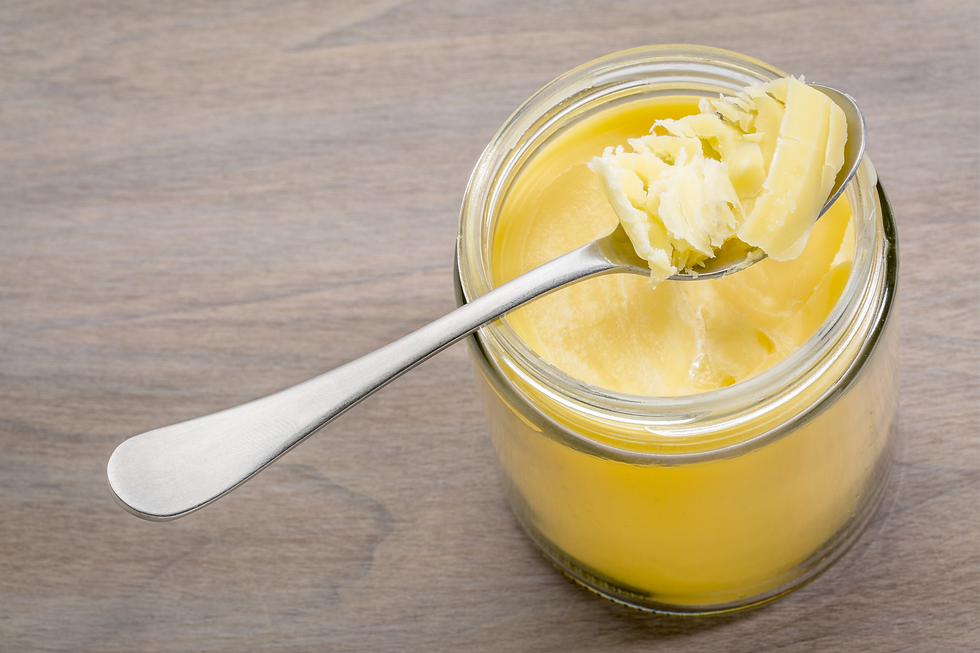The Importance of Ghee
- Jeff Perlman

- Nov 24, 2019
- 3 min read

Ghee (clarified butter) has a long and fascinating history. It has been a staple in Indian cooking for centuries and was first documented in the 17th-century Ayurvedic text Bhvaprakasa. Ghee transcends the cooking realm as it is often used in religious ceremonies and healing arts in Indian culture.
"Ghee is sweet in taste and cooling in energy, rejuvenating, and good for the eyes and vision. Enkindles digestion bestows luster and beauty, enhances memory-stamina, increases the intellect, promotes longevity, and is an aphrodisiac and protects the body from disease". Bhvaprakasa 17th Century Ayurvedic Text
Ghee is clarified butter; the process of clarifying butter is called rendering. When butter melts, Ghee separates from the water (foam on the top), and the milk solids (which collect on the bottom), and the remaining oil is the Ghee.
Fats are essential to life, and vitamins A, D, E, and K are only made available to the body when taken with fats. Fats also provide essential fatty acids (EFAs). They are essential because the body cannot make them, and we need them to live. EFAs (Omega 3 and 6) are now famed for their ability to provide anti-inflammatory eicosanoids, assist with intercellular signaling, and regulate DNS's production of inflammatory cytokines.
Saturated fats have a bad public image, as excessive consumption has become associated with an increased risk of atherosclerosis, stroke, and coronary heart disease. The controversy regarding this research and findings has not differentiated between saturated fats and synthetically generated saturated trans fatty acids.
However, this is a misconception of the nature of saturated fats, as some are healthy, such as Ghee and coconut oil. Saturated fats are made from both short-chain fatty acids and long-chain fatty acids. Short-chain fatty acids are easy to digest, whereas long-chain fatty acids are not. Long-chain fatty acids are associated with blood clotting, thrombosis, and cancer. So, short-chain fatty acids are healthy and help promote the production of hormones and strengthen cellular membranes.
Saturated fats have a bad public image, as excessive consumption has become associated with an increased risk of atherosclerosis, stroke, and coronary heart disease. The controversy regarding this research and findings has not differentiated between actually saturated fats and synthetically generated saturated trans fatty acids. However, this is a misconception of the nature of saturated fats, as some are healthy, such as Ghee and coconut oil.
Saturated fats have a bad public image, as excessive consumption has become associated with an increased risk of atherosclerosis, stroke, and coronary heart disease. The controversy regarding this research and findings has not differentiated between truly saturated fats and synthetically generated saturated trans fatty acids. However, this is a misconception of the nature of saturated fats, as some are healthy, such as Ghee and coconut oil.
Ghee is composed primarily of saturated fat. It contains approximately 14 grams of fat per tablespoon but has no artificial additives, preservatives, or trans fats. Consuming large quantities of Ghee is obviously unhealthy, but because of its rich flavor, it can be used sparingly to full effect, making it more suitable for low-fat diets. One tablespoon of Ghee instead of four tablespoons of butter or cooking oil is a good guideline.
In general, Ghee is rich in antioxidants and aids in the absorption of vitamins and minerals from other foods, feeding all layers of the body's tissues and serving to strengthen the immune system. Ghee improves memory, makes the body flexible, and lubricates all connective tissues. Ghee also has a high concentration of butyric acid, a fatty acid that contains anti-viral properties and is believed to inhibit the growth of cancerous tumors.
Ghee lacks hydrogenated oils and is a popular choice for health-conscious cooks. Additionally, since all the milk proteins have been removed during the clarifying process, Ghee gains further nutritional value because it's lactose-free, making it a safer alternative for lactose-intolerant people.



Comments